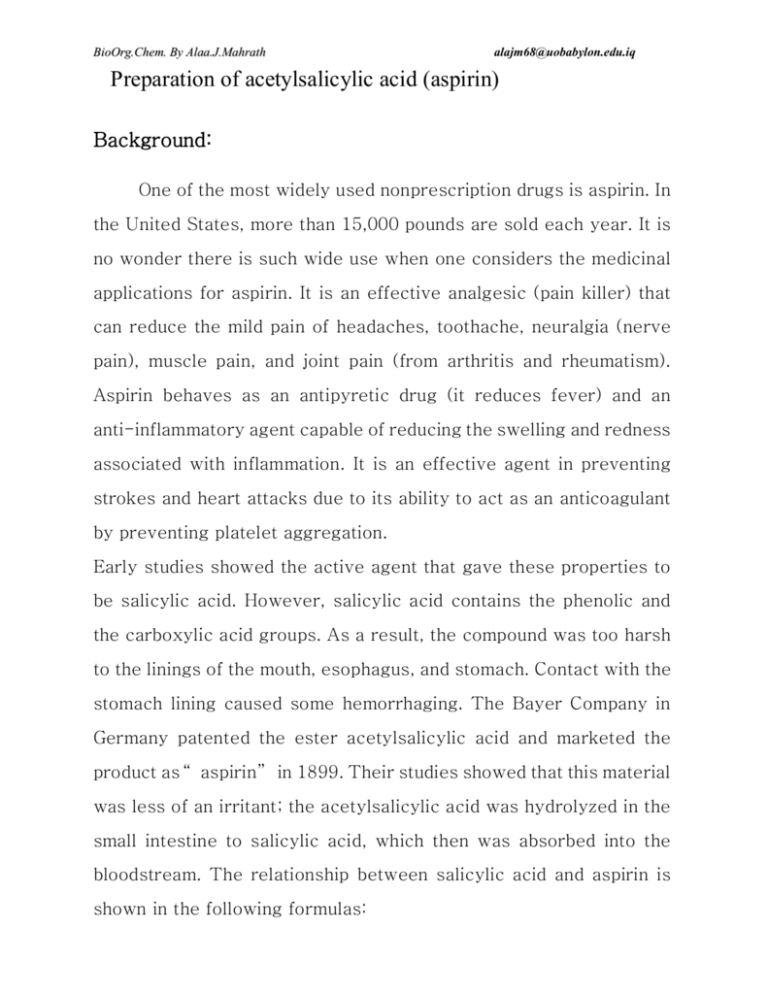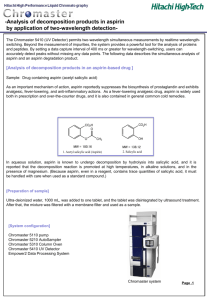BPreparation of acetylsalicylic acid (aspirin)
advertisement

BioOrg.Chem. By Alaa.J.Mahrath BPreparation alajm68@uobabylon.edu.iq of acetylsalicylic acid (aspirin) Background: One of the most widely used nonprescription drugs is aspirin. In the United States, more than 15,000 pounds are sold each year. It is no wonder there is such wide use when one considers the medicinal applications for aspirin. It is an effective analgesic (pain killer) that can reduce the mild pain of headaches, toothache, neuralgia (nerve pain), muscle pain, and joint pain (from arthritis and rheumatism). Aspirin behaves as an antipyretic drug (it reduces fever) and an anti-inflammatory agent capable of reducing the swelling and redness associated with inflammation. It is an effective agent in preventing strokes and heart attacks due to its ability to act as an anticoagulant by preventing platelet aggregation. Early studies showed the active agent that gave these properties to be salicylic acid. However, salicylic acid contains the phenolic and the carboxylic acid groups. As a result, the compound was too harsh to the linings of the mouth, esophagus, and stomach. Contact with the stomach lining caused some hemorrhaging. The Bayer Company in Germany patented the ester acetylsalicylic acid and marketed the product as “ aspirin” in 1899. Their studies showed that this material was less of an irritant; the acetylsalicylic acid was hydrolyzed in the small intestine to salicylic acid, which then was absorbed into the bloodstream. The relationship between salicylic acid and aspirin is shown in the following formulas: BioOrg.Chem. By Alaa.J.Mahrath alajm68@uobabylon.edu.iq Aspirin still has side effects. Hemorrhaging of the stomach walls can occur even with normal dosages. These side effects can be reduced through the addition of coatings or through the use of buffering agents. Magnesium hydroxide, magnesium carbonate, and aluminum glycinate, when mixed into the formulation of the aspirin (e.g., Bufferin), reduce the irritation. This experiment will acquaint you with a simple synthetic problem in the preparation of aspirin. The preparative method uses acetic anhydride and an acid catalyst, like sulfuric or phosphoric acid, to speed up the reaction with salicylic acid. If any salicylic acid remains unreacted, its presence can be detected with a 1% iron(III) chloride solution. Salicylic acid has a phenol group in the molecule. The iron(III) chloride gives a violet color with any molecule possessing a phenol group. Notice the aspirin no longer has the phenol group. Thus a pure sample of aspirin will not give a purple color with 1% iron(III) chloride solution. BioOrg.Chem. By Alaa.J.Mahrath alajm68@uobabylon.edu.iq rocedure Preparation of Aspirin: 1. Prepare a bath using a 400-mL beaker filled about half way with water. Heat to boiling. 2. Take 2.0 g of salicylic acid and place it in a 125-mL Erlenmeyer flask. Use this quantity of salicylic acid to calculate the theoretical or expected yield of aspirin . Carefully add 3 mL of acetic anhydride to the flask and, while swirling, add 3 drops of concentrated phosphoric acid. CAUTION! Acetic anhydride will irritate your eyes. Phosphoric acid will cause burns to the skin. Use gloves with these reagents. Handle both chemicals with care. Dispense in the hood. 3. Mix the reagents and then place the flask in the boiling water bath; heat for 15 min. (Fig. 1). The solid will completely dissolve. Swirl the solution occasionally. 4. Remove the flask from the bath and let it cool to approximately room temperature. Then, slowly pour the solution into a 150-mL beaker containing 20 mL of ice water, mix thoroughly, and place the beaker in an ice bath. The water destroys any unreacted acetic anhydride and will cause the insoluble aspirin to precipitate from solution. BioOrg.Chem. By Alaa.J.Mahrath alajm68@uobabylon.edu.iq 5. Collect the crystals by filtering under suction with a Büchner funnel. The assembly is shown in Fig. 1 6. The Büchner funnel is inserted into the filter flask through either a filtervac, . Filter paper is then placed into the Büchner funnel. Be sure that the paper lies flat and covers all the holes. 7. Wash the crystals with two 5-mL portions of cold water, followed by one 10-mL portion of cold ethanol. 8. Using a spatula, place the crystals between several sheets of paper toweling or filter paper and press dry the solid. 9. Weigh the filter paper with crystals. Calculate the weight of crude aspirin . Determine the percent yield . Determine the Purity of the Aspirin: 1. The aspirin you prepared is not pure enough for use as a drug and is not suitable for ingestion. The purity of the sample will be tested with 1% iron(III) chloride solution and compared with a commercial aspirin and salicylic acid. 2. Label three test tubes (100 X 13 mm) 1, 2, and 3; place a few crystals of salicylic acid into test tube no. 1, a small sample of your aspirin into test tube no. 2, and a small sample of a crushed commercial aspirin into test tube no. 3. Add 5 mL of distilled water to each test tube and swirl to dissolve the crystals. 3. Add 10 drops of 1% aqueous iron(III) chloride to each test tube. BioOrg.Chem. By Alaa.J.Mahrath alajm68@uobabylon.edu.iq 4. Compare and record your observations. The formation of a purple color indicates the presence of salicylic acid. The intensity of the color qualitatively tells how much salicylic acid is present. Chemicals and Equipment 1. Acetic anhydride 2. 3. 4. 5. 6. 7. 8. 9. 10. 11. 12. Concentrated phosphoric acid, H3PO4 Commercial aspirin tablets 95% Ethanol 1% Iron(III) chloride Salicylic acid Boiling chips Büchner funnel, small 250-mL filter flask Filter paper Filtervac or neoprene adapter Hot plate BioOrg.Chem. By Alaa.J.Mahrath alajm68@uobabylon.edu.iq PRE-LAB QUESTIONS: v List four medicinal applications for aspirin. v Draw the structure of aspirin. Should this compound test positive with 1% iron(III) chloride solution? Explain your answer. v Aspirin can irritate the stomach. What functional group in the molecule is responsible for this effect? v How do the buffering agents that are added to aspirin tablets relieve the irritating side effects? BioOrg.Chem. By Alaa.J.Mahrath alajm68@uobabylon.edu.iq NAME SECTION PARTNER GRADE DATE REPORT SHEET 1. Theoretical weight : 180 g aspirin 1 mole _____________g salicylic acid X --------- X -----------1 mole 138 g salicylic acid =-------------g Percentage Yield of Aspirin = (Exp. Wt / Thero. Wt ) × 100% aspirin 2. Weight of 50-mL beaker _________ g 3. Weight of your aspirin and beaker. _________ g 4. Weight of your aspirin: (3) — (2) _________ g 5. Percent yield: [(4)/(1)] X 100 = % _________ % 6. Iron(III) chloride test. BioOrg.Chem. By Alaa.J.Mahrath alajm68@uobabylon.edu.iq POST-LAB QUESTIONS: 1. How was the rate of the reaction increased? 2. What would happen to your percent yield if in step no. 11 of the procedure you failed to dry completely your aspirin preparation by omitting the drying between filter paper? 3. A student expected 12.0 g of acetylsalicylic acid, but obtained only 7.5 g. What is the percentage yield? 4. Two nonprescription pain relievers are available as substitutes for aspirin: Ibuprofen and Naproxen. Would each of these drugs give a positive phenol test? Explain your answer. What functional group is common to each of these drugs? BioOrg.Chem. By Alaa.J.Mahrath alajm68@uobabylon.edu.iq AJM .BioorgChem.





